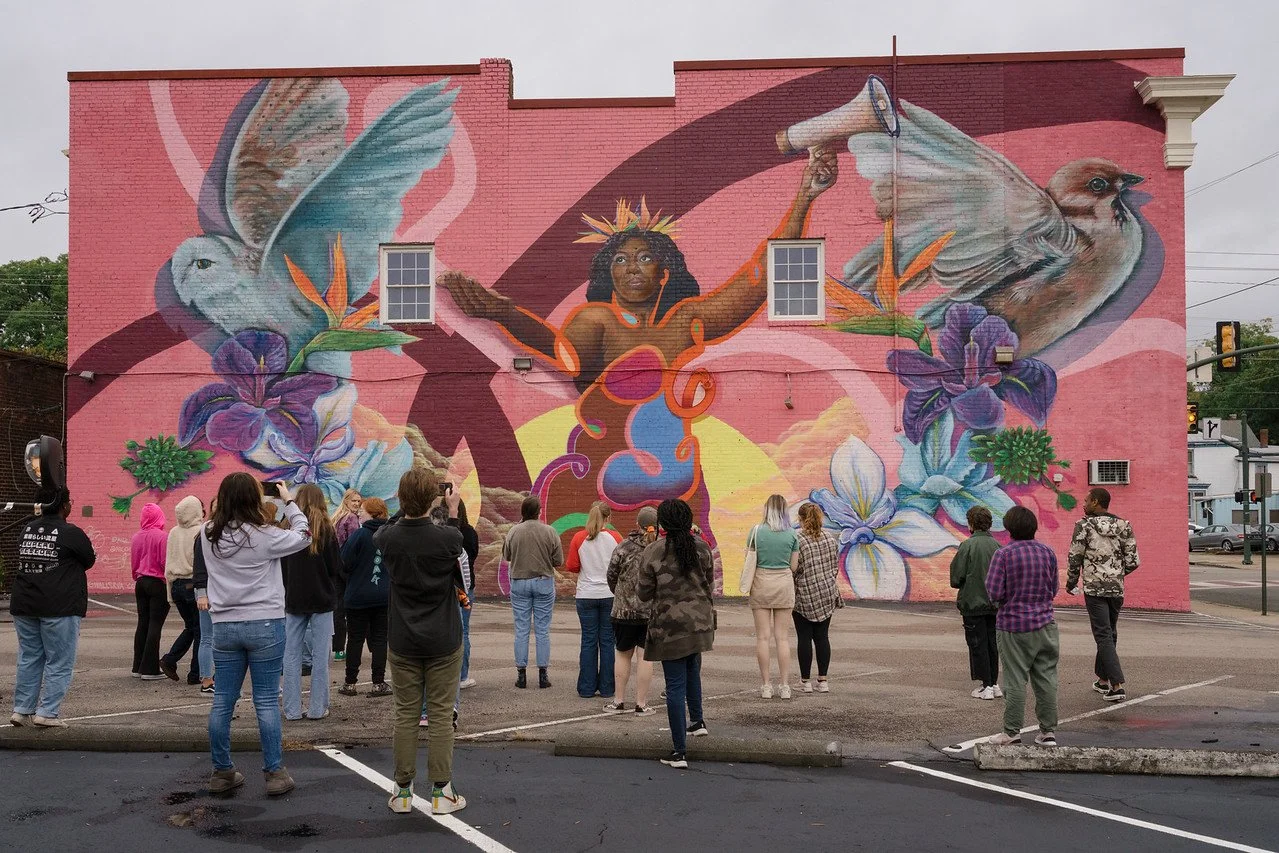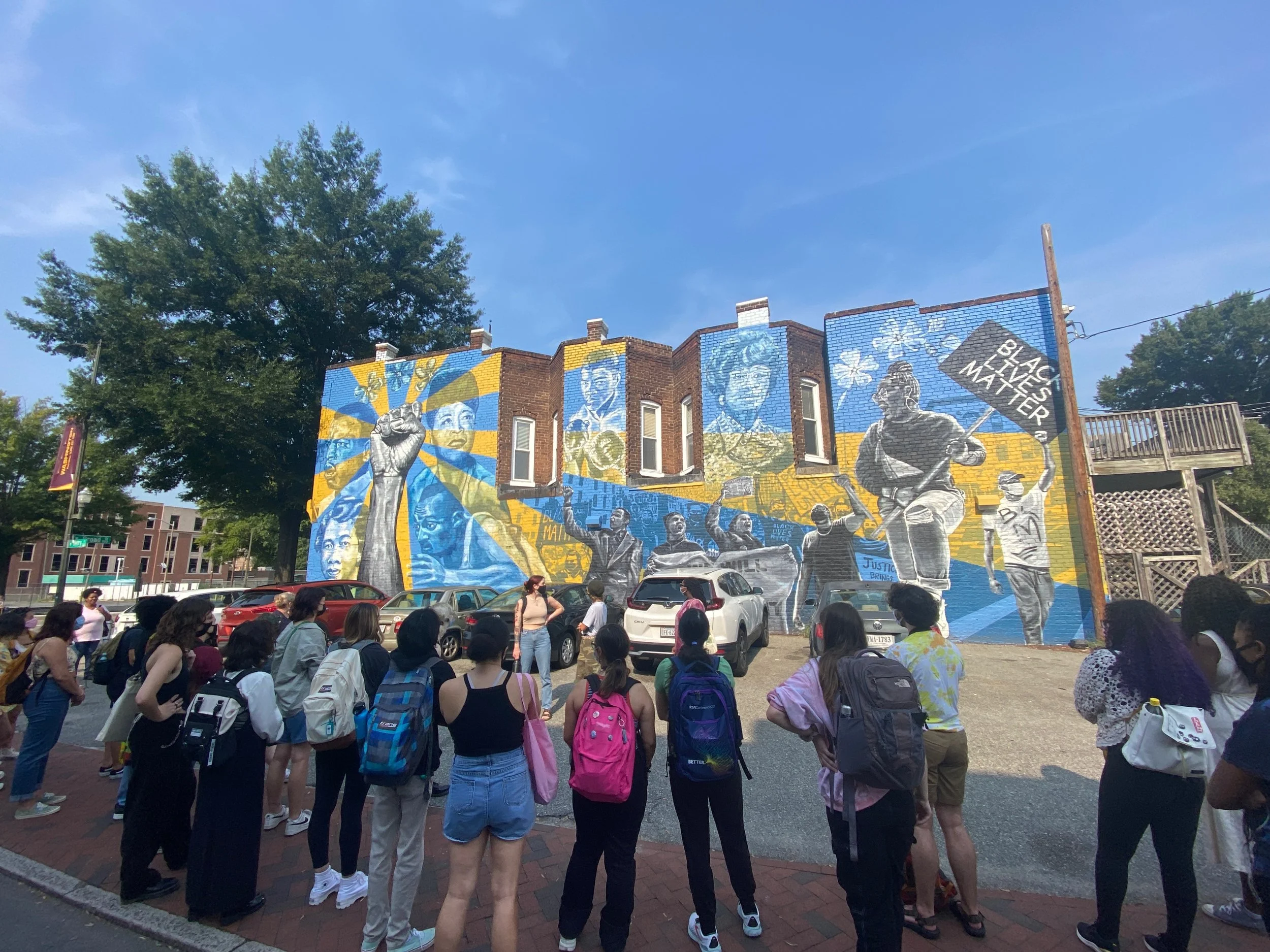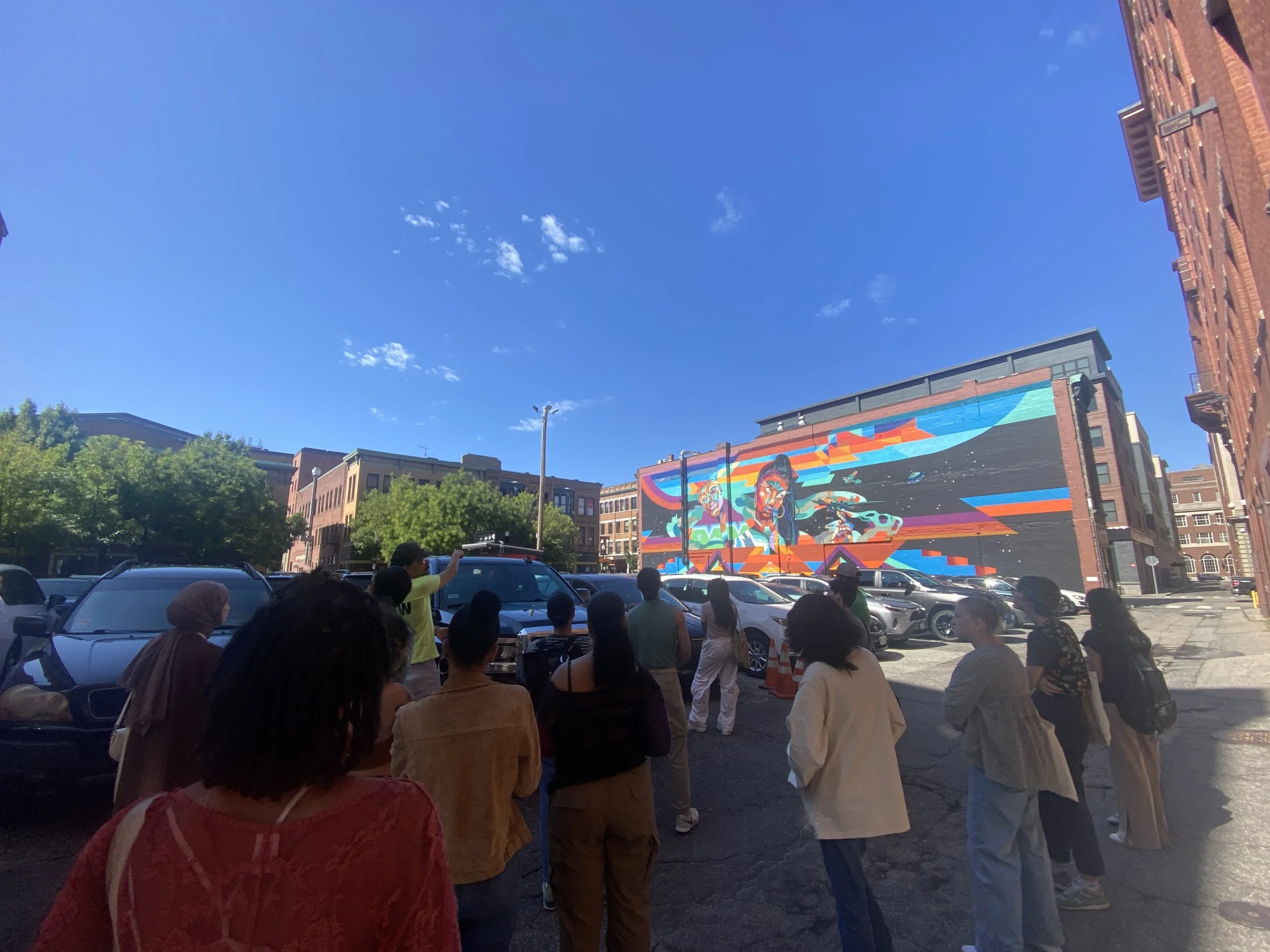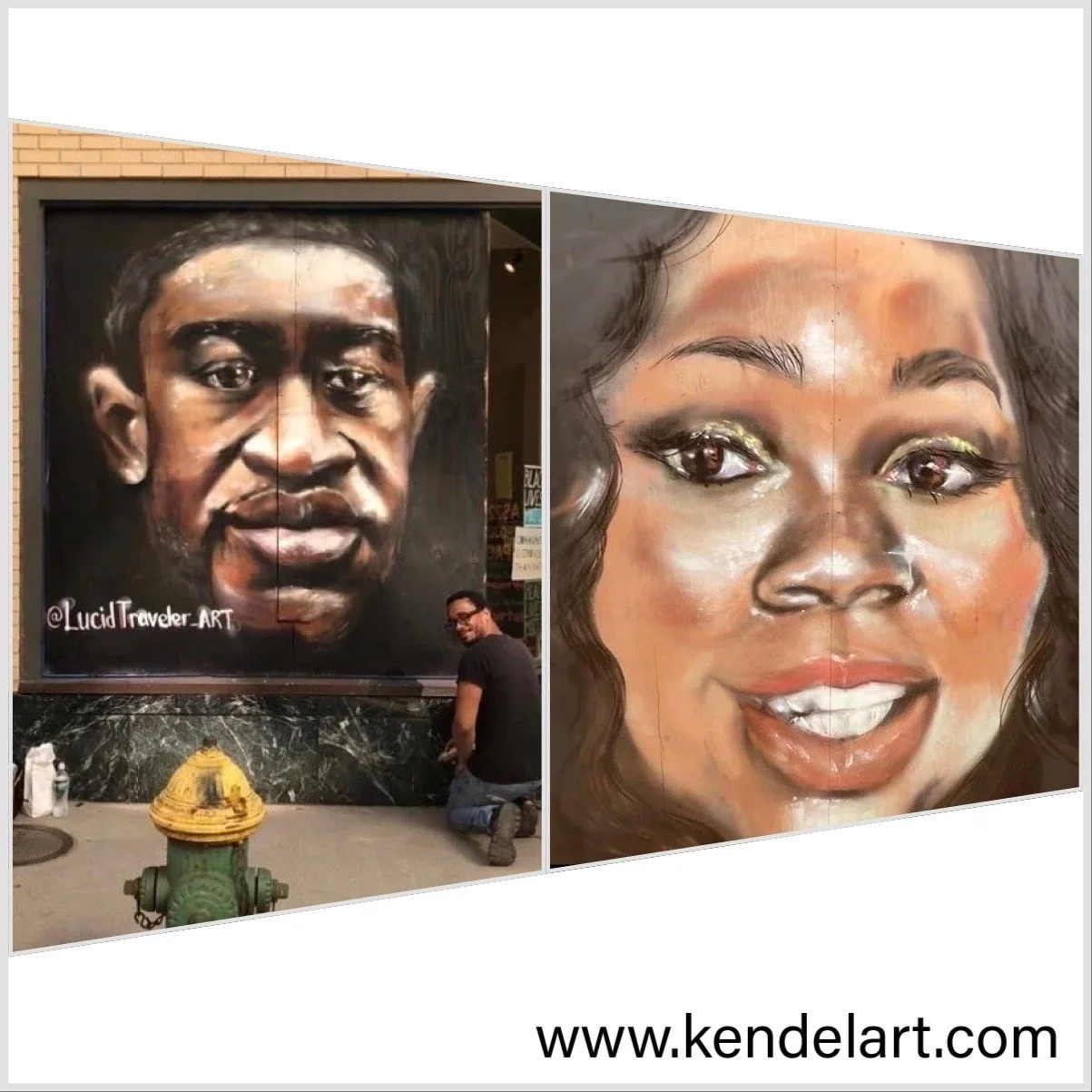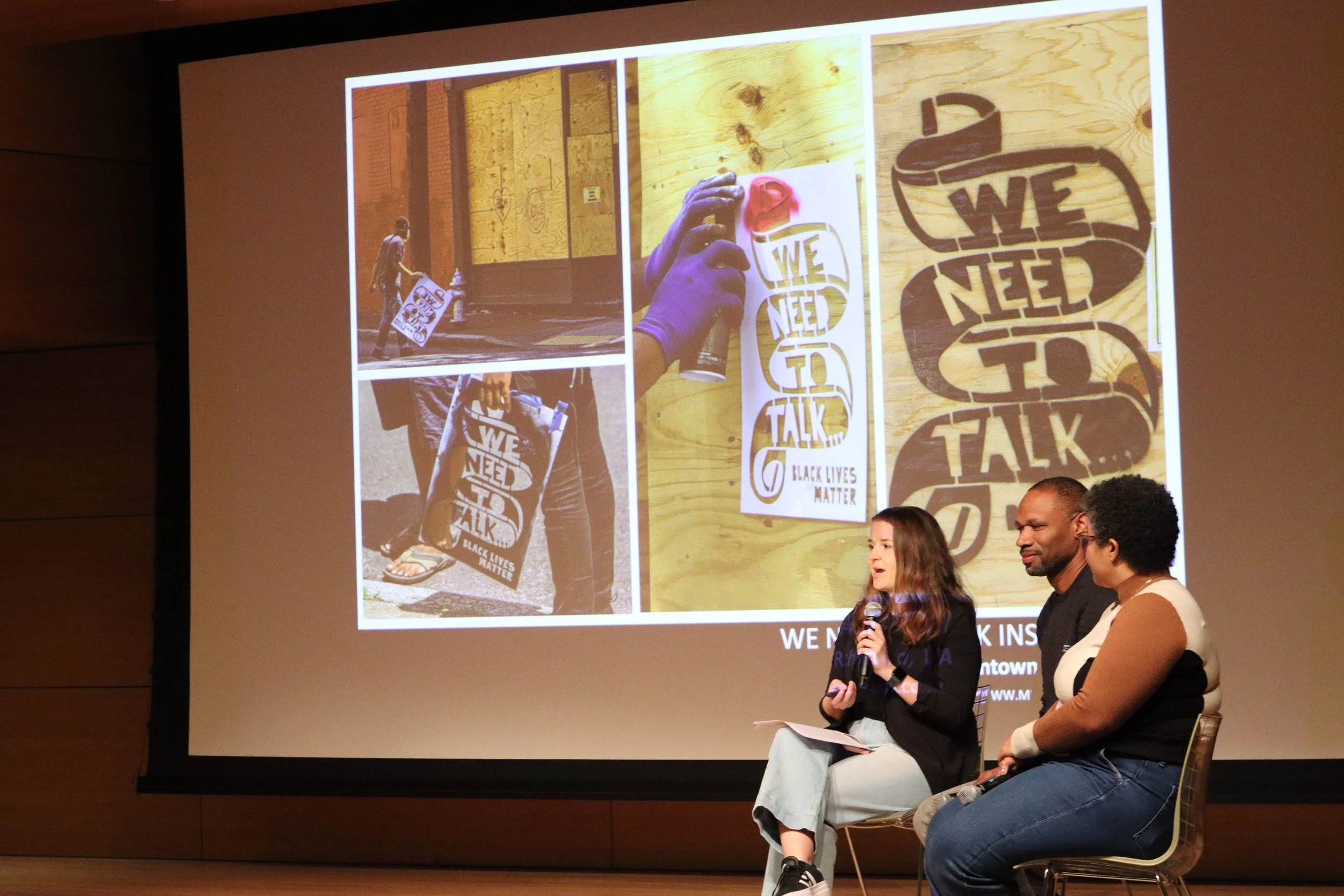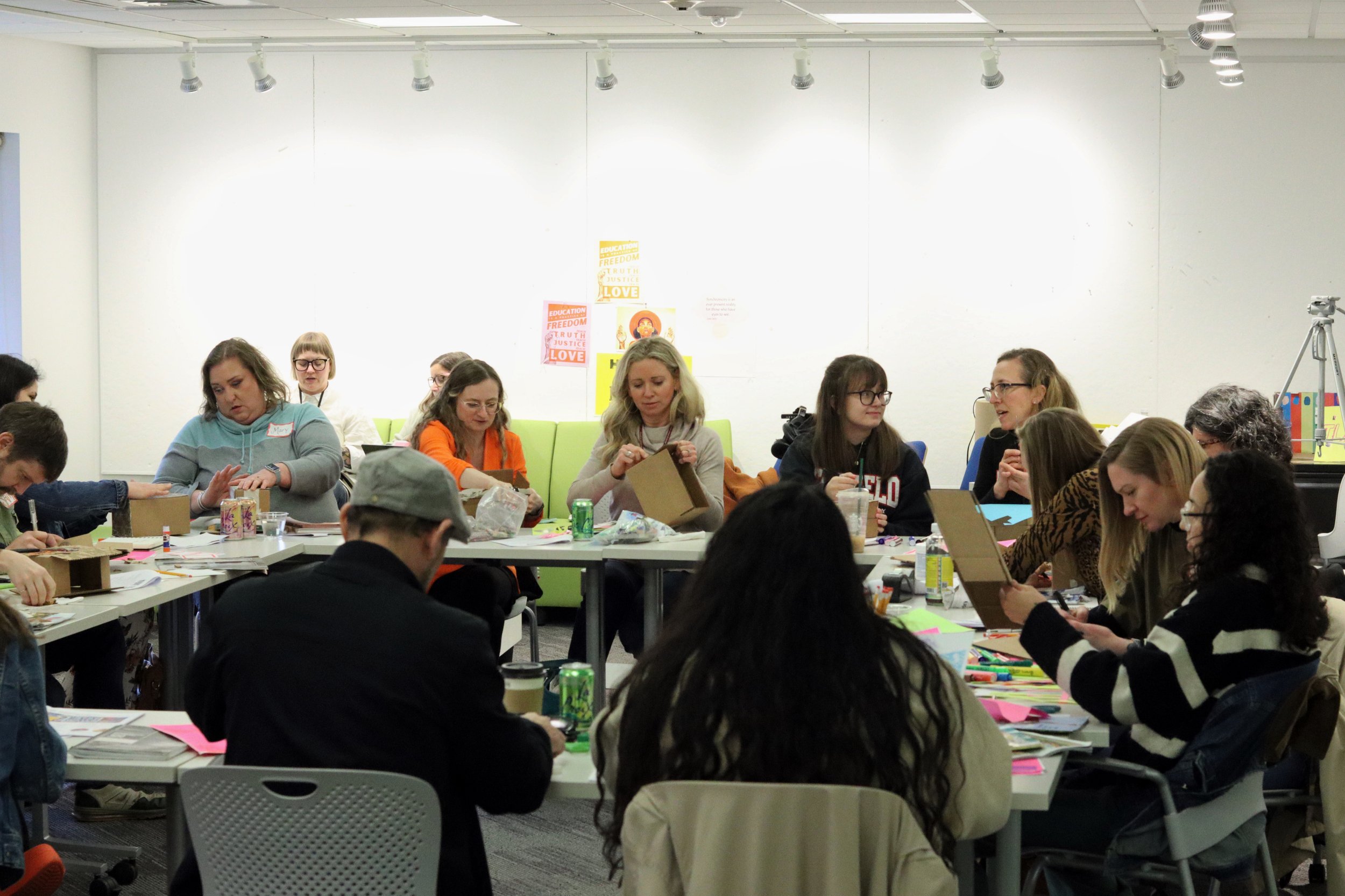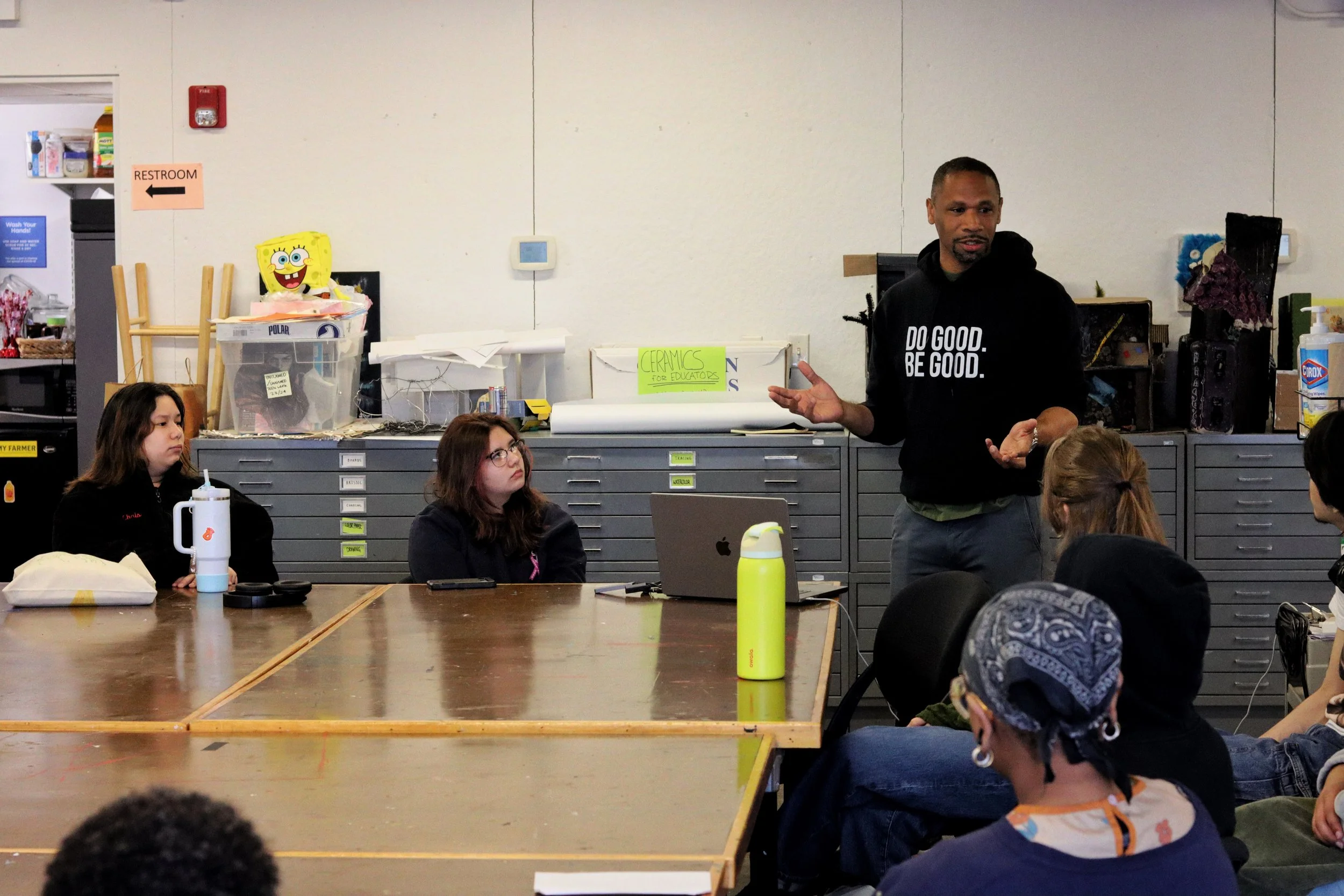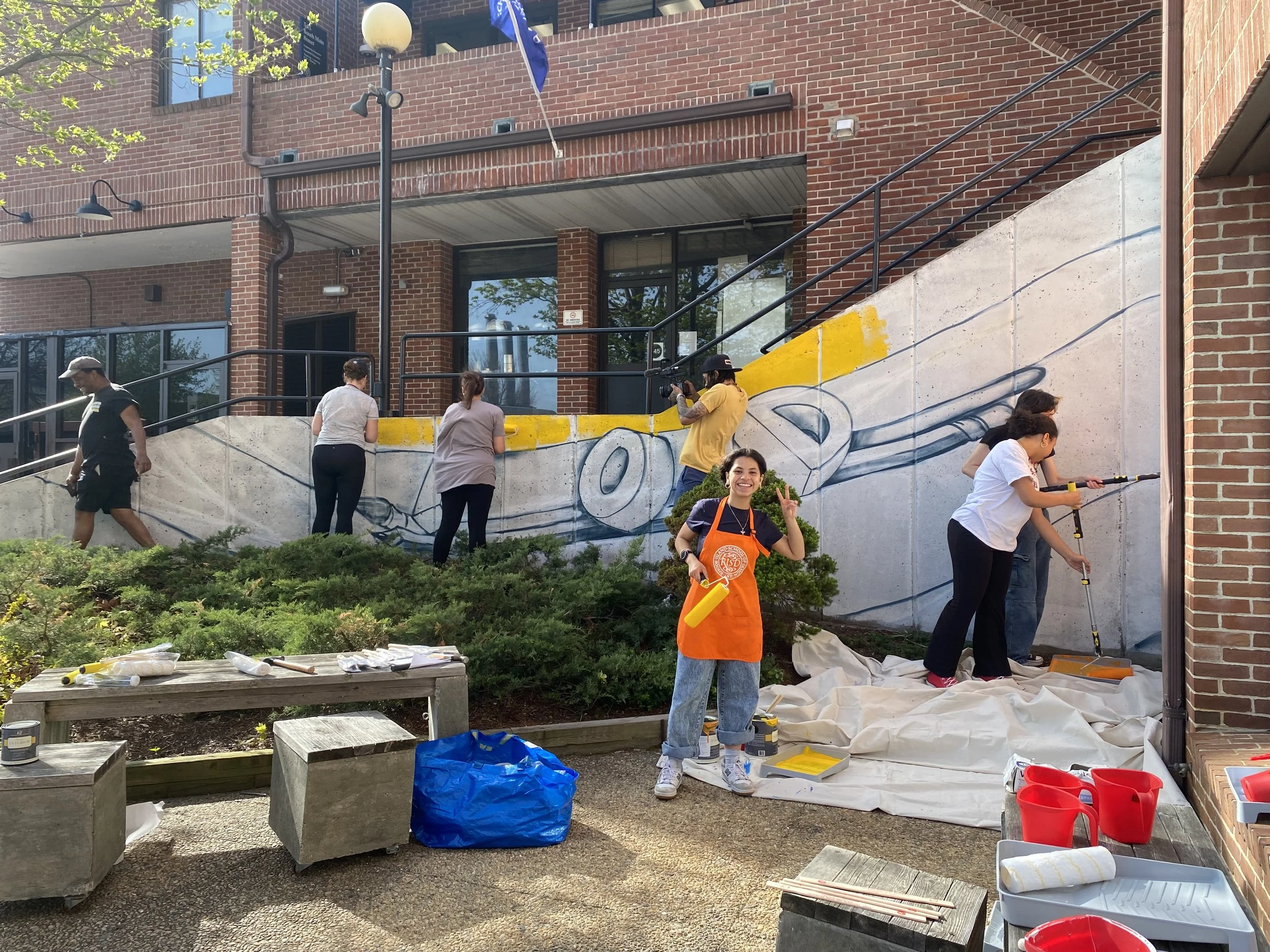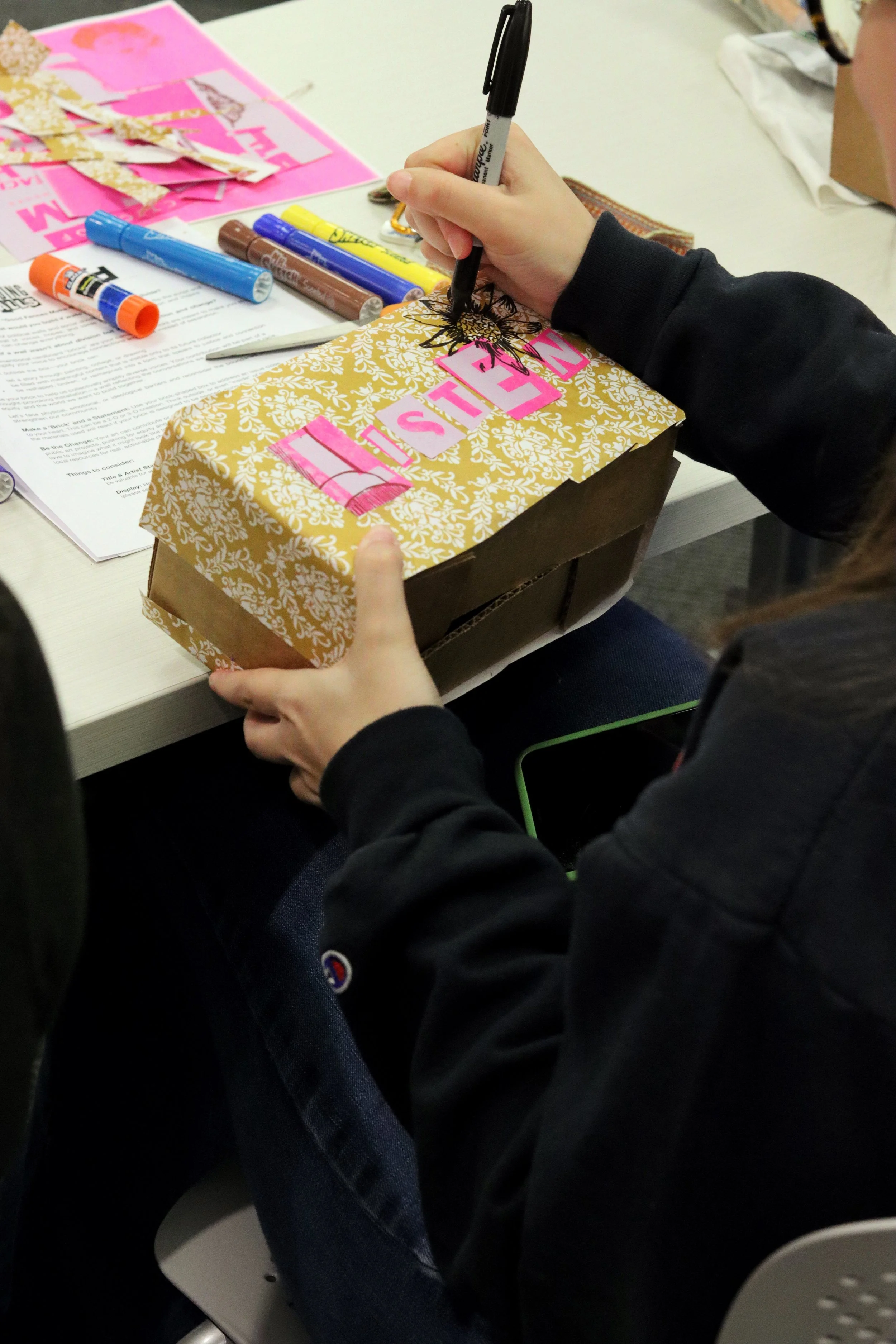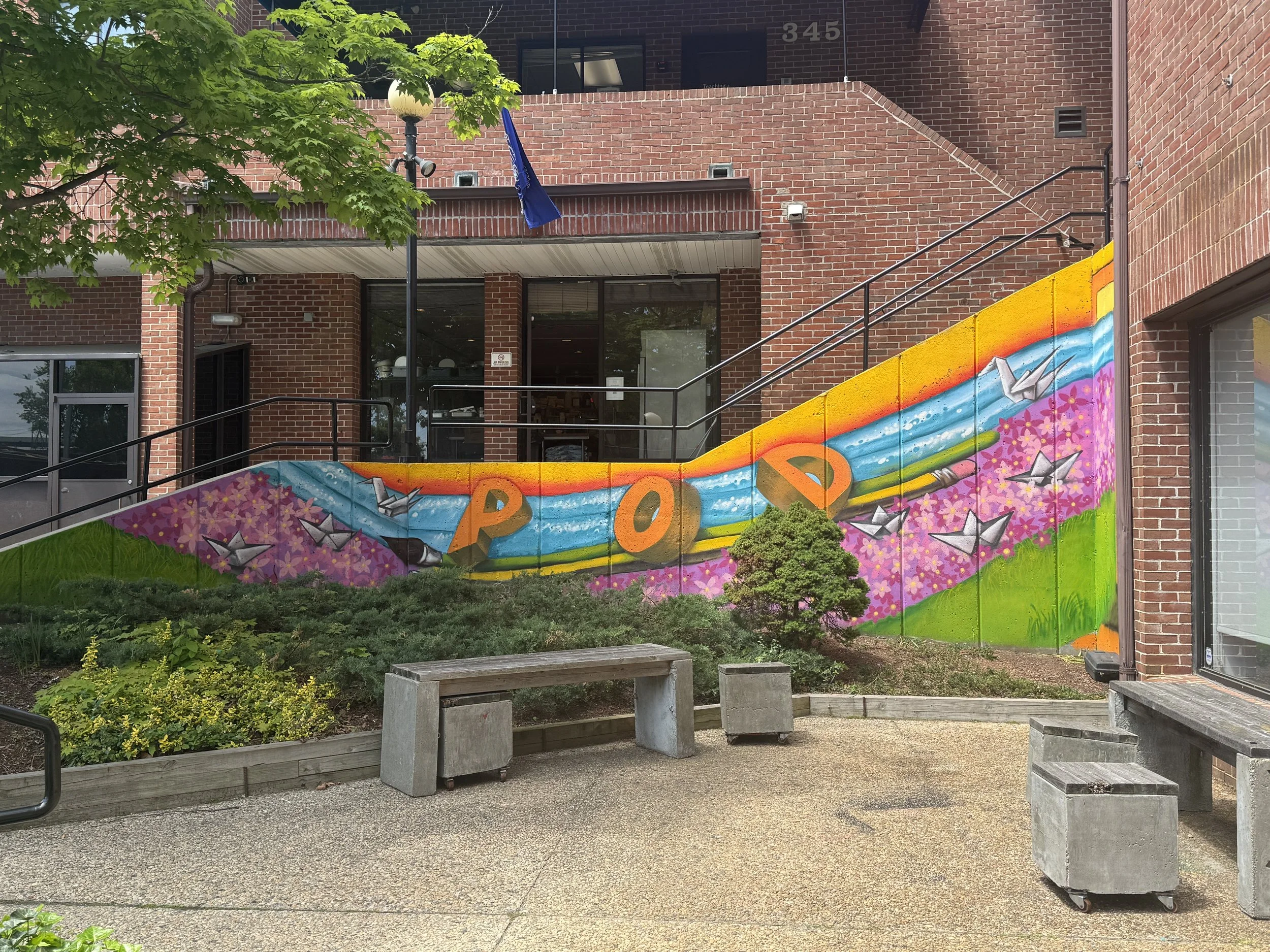The Beautiful Ripple Effects of Mending Walls
Caitlin M. Black, Ph.D
Beginnings
A little over five years ago, on July 9, 2020, in the wake of the global COVID-19 pandemic, the murder of George Floyd, and global uprisings for racial justice, I moved to Richmond, Virginia. I was immediately captivated by new murals appearing, what felt like daily, in my neighborhood. Prior to my move, I was informed of the city’s vibrant art scene, but these new murals had a different emotional quality. My curiosity was immediately piqued, and I’d soon learn the murals that were going up in rapid succession were all a part of Mending Walls.
Having spent nearly a decade as an art educator in public schools, the mission of Mending Walls gave life to so many of my own thoughts and beliefs around the power of art to foster dialogue, build empathy, and prompt connection across differences. After participating in a virtual civic talk, I connected with Mending Walls’ founder, Hamilton Glass, and I have had the privilege and honor of being involved with Mending Walls in various capacities ever since. Mending Walls has transformed my thinking, teaching, and life in deeply meaningful ways – I am forever grateful for the people I’ve connected with and how my experiences with Mending Walls continue to influence and inspire my approach to building community.
Caitlin paints during a Mending Walls community paint day in September 2020 in downtown Richmond at The Journey Forward mural painted by Nadd Harvin & Humble. Photo credit: Katrina Hecksher Jones
Community-Engaged Art Teacher Preparation
From 2020-2023 I had the privilege of working with and learning from preservice art education students at Virginia Commonwealth University (VCU). During this time, pandemic restrictions necessitated a reimagination of an experiential learning component for a foundational art education course I was teaching. With the Mending Walls team’s approval, I designed and embedded activities into multiple art education courses providing opportunities for the art education preservice students, to explore, engage with, and develop curricular materials for the Mending Walls project. These engagements provided opportunities for the preservice teachers to recognize asset-based approaches to education, practice the development of intergenerational and interdisciplinary lessons, and utilize the arts to prompt critical conversations on important issues including but not limited to: racial and social justice, housing justice, food justice, mental health, ableism, restorative justice, and dismantling the school to prison pipeline.
Caitlin’s VCU class visiting Liberty Leads Her People painted by Auz Miles and Nico Cathcart with Hamilton Glass and Nadd Harvin in the fall of 2022. Photo credit: Lily Parker
Mending Walls’ intentional interracial pairings of artists; emphasis on direct, local community collaboration; and facilitation of difficult but meaningful conversations on racial and social justice prompted my own critical reflections as a human and educator, while providing a local, community-based entry point for engaging the preservice art educators I was working with, with these complex and sometimes uncomfortable topics. While befriending discomfort (Kantawala et. al, 2022), and embracing radical empathy (Wilkerson, 2020), engagement with the project provided opportunities for careful consideration of the various ways systemic oppression manifests (both overtly and subtly). Further, it leveraged diversity and community as vital (Howard, 2021) assets for learning. This work launched a journey that ultimately shaped my dissertation and continues to shape my pedagogical practice.
VCU preservice art education students engaging in discussion in front of Voices of Perseverance, painted by Jason Ford and Ed Trask in the fall of 2021. Photo credit: Caitlin Black
From Practice to Research: A Qualitative Study
In order to better understand how the preservice art educators I was working with perceived the impact of using the Mending Walls project in the development of pedagogy and curriculum in their foundational coursework, I conducted a qualitative study that merged the methodological frameworks of case study and narrative inquiry. The study was completed in partnership with 11 preservice art education students with diverse representation across race, gender, and nationality (Black, 2023). Through in-depth analysis of transcribed interviews, visual journal entries, field notes, and reflective writings, five major themes were identified:
1. The Significance of Community
The preservice art educators expressed that engaging with the Mending Walls project influenced their thinking about involving the community in education, taking time to get to know the communities in which they are teaching, and the importance of honoring community expertise. They shared how engagement with Mending Walls propelled their desire to build safe classroom communities for their future students, embedding opportunities for conversation, dialogue, and student voice in curriculum. In designing supportive educational communities of care, participants acknowledged the need for affirmation of differences, honoring of diverse identities, recognition of intersectionality, and cultivating spaces for empathy and connection.
2. Engaging with Local Artists
Engagement with local artists proved transformative. Many of the preservice art educators described how engagement with various Mending Walls’ artists prompted their thinking about the inclusion of local, contemporary artists in their curriculum and how they might engage or collaborate with local artists in the future. Further, participants noted a desire to design community-engaged projects that invite artists in and/or bring students outside the classroom walls.
3. Public Art as Pedagogy
Experiencing murals in person shifted the preservice art educators’ views on accessibility, learning environments, and what counts as "art." Public art became both content and context for learning—an entry point into critical conversations. The preservice art educators denoted the desire to design similar engaging experiences for their own students in the future.
4. Social Justice in Curriculum
As a result of engaging with the Mending Walls project, the preservice art educators conveyed the need to design curriculum that actively addresses social justice issues in the art classroom. They discussed their desire to move through fear and create safe spaces for their future students. The preservice art educators described the importance of affirming differences and practicing radical empathy in building and strengthening communities.
5. Documentation of Process
The preservice art educators indicated that engagement with the Mending Walls documentary, podcasts, and website increased their understanding and connection to the coursework. They discussed how the dissemination of stories and narratives of the process behind the creation of the artwork in the Mending Walls project was refreshing and enlightening. By listening to the Mending Walls’ artists discuss their process, the preservice art educators also expressed a desire to invite dialogue and reflective process-driven instruction in their future teaching practice.
The preservice art educators additionally shared that their visual journal assignments provided opportunities for creative reflective practice that provided space for both individual reflection and community building through the affirmation of difference - vulnerably sharing their different approaches to the same prompt with their peers.
TLDR (Too Long, Didn’t Read); it’s OK here are 3 QUICK TAKEWAYS -
Provide Opportunities for Experiential Learning
We had discussions outside, standing at various Mending Walls’ murals, but this could happen in a number of ways even if public art isn’t visible in the community where you are located. Consider the stories that are visible, and perhaps more importantly the stories that are missing from our public spaces. How might you design learning experiences that take place in and with the community?
Creatively Reflect with Visual Journals
Students found immense value in the visual journaling practice - by emphasizing process over product you can encourage students to artistically reflect individually while also inviting them to share responses with each other. The process of sharing is an act of community building - actively affirming and appreciating our differences and unique approaches to the same prompt.
Engage with Local Artists
Connect with your local arts community! Invite artists in, visit artists at their studio, meet up with artists at their mural(s) - in-person engagements with contemporary, local artists are impactful.
Figure 4: Examples of visual journals from Caitlin’s VCU courses reflecting on the work of Mending Walls.
Expanding the Work - Ripples to Rhode Island
My personal transformative experience with the Mending Walls, in addition to the many hours spent marinating on the in-depth reflections of my former students, stayed close to my heart as I moved to Providence, Rhode Island for a job opportunity in 2023. While I was sad to leave the Richmond community and dear friends I made through Mending Walls, I was fortunate to have a blueprint for how to seek out people invested in and committed to community-engaged work.
My experience with Mending Walls informed the development of a special topics course I designed and taught at Rhode Island School of Design (RISD), titled, Critical Curiosities & Creative Encounters: Public Art as Pedagogy. This multidisciplinary course encouraged critical thinking by positioning public spaces as sites of inquiry in the development of art + design practice. Students across departments, such as architecture, illustration, jewelry + metalsmithing, painting, and more, designed personal investigations considering issues of equity, accessibility, spatial histories, community-engagement, and the complexities of art in the public realm.
Caitlin’s RISD students in her course titled Critical Curiosities & Creative Encounters: Public Art as Pedagogy in Fall 2023 in Providence, RI standing in front of mural titled, Salt Water painted by Garden of Journey in 2021. Photo credit: Caitlin Black
As I worked to acquaint myself with the local arts scene and organizations in Providence, I met local artist, Kendel Joseph. In 2020, as downtown storefronts were boarded up in Providence, Kendel, similar to Hamilton, took to the streets with his artwork. He created murals honoring George Floyd and Breonna Taylor.
Left - Artist, Kendel Joseph, in front of his 2020 mural honoring George Floyd; Right - Close up of Kendel Joseph 2020 mural honoring Breonna Taylor; both in Providence, RI. Photos from: www.kendelart.com
Additionally, Kendel highlighted a variety of local artists and activists in public murals, specifically amplifying people of color who have been influential in the Providence art community (Connecting, 2023). In early conversations with Kendel, I learned he was an alumnus of Project Open Door (POD) - a community arts program run by RISD’s Department of Teaching + Learning in Art + Design (where I work currently), that helps local high school students develop artistic skills through free art and design programming (Project open door, n.d.). Having recognized the significance of engaging with local artists through the Mending Walls project and realizing that the year 2025 would be POD’s 20th anniversary celebration, I saw a beautiful opportunity for a collaboration.
During the spring of 2025, with generous support from the RISD Professional Development Fund, Mending Walls served as a model of social justice and community-engaged pedagogy and art-making, as we hosted a series of educational, community-engaged events. These included:
A public screening of the Emmy award winning Mending Walls documentary followed by an artist talk with Mending Walls co-directors, Hamilton and Taekia Glass
Caitlin Black talks with Hamilton & Taekia Glass following the documentary screening at the RISD Museum in Providence, RI in April 2025. Photo credit: Phoenix Kabali
A professional development workshop with local PreK-12 art educators
Local educators engage in a professional development workshop in the Department of Teaching + Learning in Art + Design at RISD in Providence, RI in April 2025. Photo credit: Phoenix Kabali
A workshop with POD high school students co-facilitated by Kendel Joseph and Hamilton Glass
Hamilton Glass shared with POD students the secret sauce is “showing your work… the real bravery of public art and art in general is showing your work and not being afraid if it doesn’t look the way it looks in your mind.” Photo credit: Phoenix Kabali
A 10-week public art course for POD high school students led by local artist and Project Open Door (POD) alum, Kendel Joseph
POD students begin painting their collaboratively designed mural under the guidance of teaching artist, Kendel Joseph, Spring 2025. Photo credit: Lauren Allen
The collaboration provided unique opportunities to continue to explore the pedagogical potential of community-engaged public art experiences. The feedback was overwhelmingly positive.
Local art educators that participated in the Mending Walls professional development workshop shared that they enjoyed the opportunity to collaborate, connect, and make hands-on art. One educator noted, “it was good to see how accessible this kind of thinking and artmaking can be in a school setting”; while another shared how the desire and goal to find connection served “not only as a meeting point, but also as a springboard for artwork.”
Local educators engage in making during the Mending Walls workshop at RISD in April 2025. Photo credit: Phoenix Kabali]
The 10-week public art class for POD high school students, led by local artist and POD alum, Kendel Joseph, kicked off with collaborative brainstorming around the questions “What is public art?” and "What is community-engagement?” Students engaged in conversations before and after watching the Mending Walls documentary. Kendel led students on a tour of murals in the city of Providence and guided students in painting exploration at the legal wall at The Avenue Concept, a local nonprofit public art organization. Despite many rainy Saturdays, students collaborated to create a cohesive mural design and installed the mural in time for the annual exhibition in May 2025.
Collaborative mural completed in May 2025 outside POD Studio in Providence, RI. Photo credit: Caitlin Black
Reflecting on the experience, POD student MiaBella, shared, “I definitely think that this has shaped me to be a better artist, a better person in general, because I’ve kind of had a more open mind coming into this class and really hearing from other people’s ideas and perspectives on certain things. We’ve even gotten into conversations about the community and how we can benefit the community and the history [in this location]... this class was a very positive outlook and a very positive experience in my life.”
Another POD student, Veah, shared, “as we kept going we started having more cross cultural discussions… we slowly began to really connect on what we wanted to see in our mural”. Veah noted, “it was hard… to make sure everyone’s ideas were included” but described the process as her favorite part “because it presented a lot of challenges we had to work through.” She also articulated that the mural brought people together, describing how people would walk by or sit outside as they painted and talk with each other.
Teaching artist, Kendel Joseph, shared, “it was a group filled with a lot of brilliant young artists with powerful ideas.” He reflected on the experience as a “true homecoming… something that was challenging… but also truly empowering.” He described sharing space with the young folks at POD as inspiring, noting it added fuel to the personal [artistic] fire. Kendel stated, “I can’t wait to paint my next mural because, you know, I got to hangout with [the students] every Saturday, and share that beautiful nature that is humanity.” In Kendel’s words, “Project Open Door just has my heart.”
The public art class poses with teaching artist Kendel Joseph and professor Caitlin Black in front of their collaborative mural during their last class in May 2025. Photo credit: Tara Black
Final Reflections - Mending Walls as a Catalyst for Building a More Just World
Ultimately, this work has deepened my understanding of the pedagogical potential of community-engaged artmaking and more specifically, Mending Walls’ potential to serve as a model of social justice and authentic community-engaged practices. It has also strengthened community partnerships in my new city and fueled research on equity-focused teacher preparation.
The Mending Walls project—and the collaborative work that has grown from it—offers a model for asset-based, culturally sustaining education (Paris & Alim, 2017) that centers multigenerational care, creativity, and justice.
I hope this reflection invites others to consider how public art, local partnerships, and community-engaged learning can transform not only students, but teachers, schools, and the communities they are a part of.
The experiences and relationships cultivated through Mending Walls have transformed not only my teaching, but my life. As I enter new community spaces, I am committed to continuing to honor Mending Walls’ mission through my pedagogy and actions. I believe through collaboration, vulnerable conversations, deep listening, and artivism we can find beauty in our differences and collectively make the world a better place.
How has Mending Walls inspired you?
We need to talk . . .
Caitlin M. Black, Ph.D
Assistant Professor in the Department of Teaching + Learning in Art + Design
Rhode Island School of Design, Providence, RI
Want to connect? Send me an email - cblack@risd.edu
References
Black, C. (2023). Assessing the perceived impact of a local, community-engaged mural project on preservice art educators in foundational coursework. Virginia Commonwealth University. https://doi.org/10.25772/4BR9-GX79
Connecting local, national, and international artists. (2023, June 9). The Avenue Concept Blog. https://theavenueconcept.org/connecting-local-national-and-international-artists/
Howard, T.C. (2021). Foreword. In Clark, P., Zygmunt, E., Tancock, S., & Cipollone, K. (Eds.),
The power of community-engaged teacher preparation: Voices and visions of hope and
healing (pp. ix-xv). Teacher College Press.
Kantawala, A., Blum, M. M., Cave, K., Cho, J., Gershon, S., Jang, E. J., Li, R., Marr, M., Mistry, A., & Watson, J. (2022). Befriending discomfort: Reflections from 1st-year graduate students in art teacher education. Art Education, 75(3), 4–8. https://doi-org.proxy.library.vcu.edu/10.1080/00043125.2022.2059326
Paris, D., & Alim, H. S. (Eds.). (2017). Culturally sustaining pedagogies: Teaching and learning for justice in a changing world. Teachers College Press.
Project open door. RISD. (n.d.). https://www.risd.edu/academics/teaching-learning-art-design/project-open-door
Wilkerson, I. (2020). Caste: The origins of our discontents. Random House.


